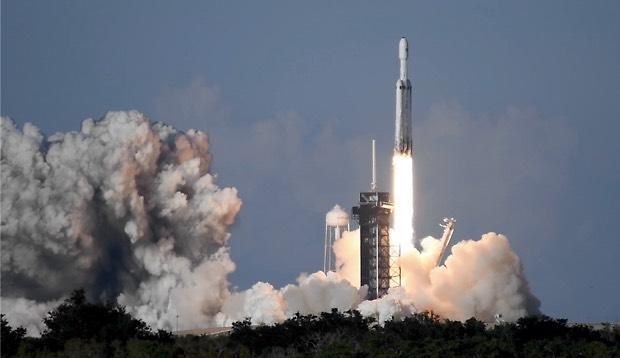SpaceX Falcon Heavy rocket thunders into space
A year after launching a Tesla roadster into deep space, a second SpaceX Falcon Heavy rocket thundered to life and streaked into space Thursday evening, putting on a spectacular show as the triple-barrel launcher boosted an advanced communications satellite into orbit for Arabsat, a Saudi-based consortium.
While putting the Arabsat 6A communications station into orbit was the primary goal of the 34-minute mission, SpaceX engineers accomplished a secondary objective in equally spectacular fashion, successfully recovering the rocket's three Falcon 9 core stages for refurbishment and re-use.
Two of the boosters executed side-by-side landings at the nearby Cape Canaveral Air Force Station, thrilling tourists and area residents with dual sonic booms as the rockets completed seemingly synchronized touchdowns just a few hundred feet apart. The central core stage flew itself to a pinpoint landing on an off-shore drone ship.
The Arabsat 6A satellite, built by Lockheed Martin for the Arabsat consortium, was released from the Falcon 9's second stage about 34 minutes after liftoff. Placed in an initially elliptical orbit, on-board thrusters will be used to put the craft in a circular orbit 22,300 miles above the equator where satellites rotate in lockstep with the Earth, ideal for communications stations.
If all goes well, SpaceX engineers will refurbish the two side boosters, add a new central core stage and ready another Falcon Heavy for launch in June or July to put more than a dozen Air Force satellites into a variety of orbits.
Running a day late because of high winds aloft, Thursday's mission began at 6:35 p.m. EDT when the rocket's 27 Merlin engines, nine per core booster, ignited and thundered to life with a rush of fire and billowing clouds of steam. After a lightning-quick round of computer checks, the 229-foot-tall rocket was released to begin its climb to space.
Generating more than 5 million pounds of thrust, the Falcon Heavy — the most powerful operational rocket in the world — quickly accelerated as it shot away to the east atop a long jet of flaming exhaust, putting on a dramatic show as it climbed out of the dense lower atmosphere. It was the first flight of a Falcon Heavy using three upgraded, more powerful "block 5" core stages.
The Falcon Heavy's two outboard boosters were jettisoned from the central core stage two-and-a-half minutes after blastoff. Operating independently, the two boosters each restarted three engines to reverse course, plunged back into the lower atmosphere and executed flawless side-by-side rocket-powered landings at the nearby Cape Canaveral Air Force Station about eight minutes after launch.
The central core stage fired a minute longer than the two outboard boosters before shutting down and turning the ascent over to the single engine powering the rocket's upper stage. The core stage then flew itself to a pinpoint landing on the off-shore droneship, "Of Course I Still Love You," stationed several hundred miles east of Cape Canaveral.
For its maiden flight in February 2018, the rocket carried a dummy payload, a cherry red Tesla Roadster with a spacesuited-mannequin, "Starman," strapped into the driver's seat. The two side boosters used for that launch were successfully recovered, but the core stage crashed attempting to reach the drone ship.
But the successful side-by-side landings, and live video showing Starman and the sleek sports car against the blue-and-white backdrop of planet Earth captivated the nation and garnered worldwide attention.
For Heavy's second flight, it was strictly business. The rocket was purchased by Arabsat, based in Riyadh, Saudi Arabia, to launch the consortium's latest satellite, a 14,252-pound relay station built by Lockheed Martin that will provide television, radio, mobile and broadband services across the Middle East, Europe and Africa.
"This new satellite will strengthen our existing fleet that offers millions of people mobile and landline communications service across the region," Khalid Balkheyour, CEO of Arabsat, said in a news release. "We look forward to completing and launching this state-of-the-art new satellite to offer even greater internet, television and radio services to our customers."
In a departure from past designs, the satellite features thin, flexible solar arrays instead of the rigid panels used on other spacecraft. The new multi-mission arrays are 30 percent lighter than more traditional panels but can generate up to 50 percent more power, or 20 kilowatts for Arabsat 6A.
With the heavy-lift power of the Falcon Heavy, the satellite was released into an initial orbit with a high point, or apogee, of nearly 56,000 miles and a low point, or perigee, of just 124 miles. On-board thrusters will circularize the orbit at the desired 22,300-mile altitude. By starting out with such a high apogee, less propellant will be required to reach the operational altitude, which translates into increased lifetime on orbit.







